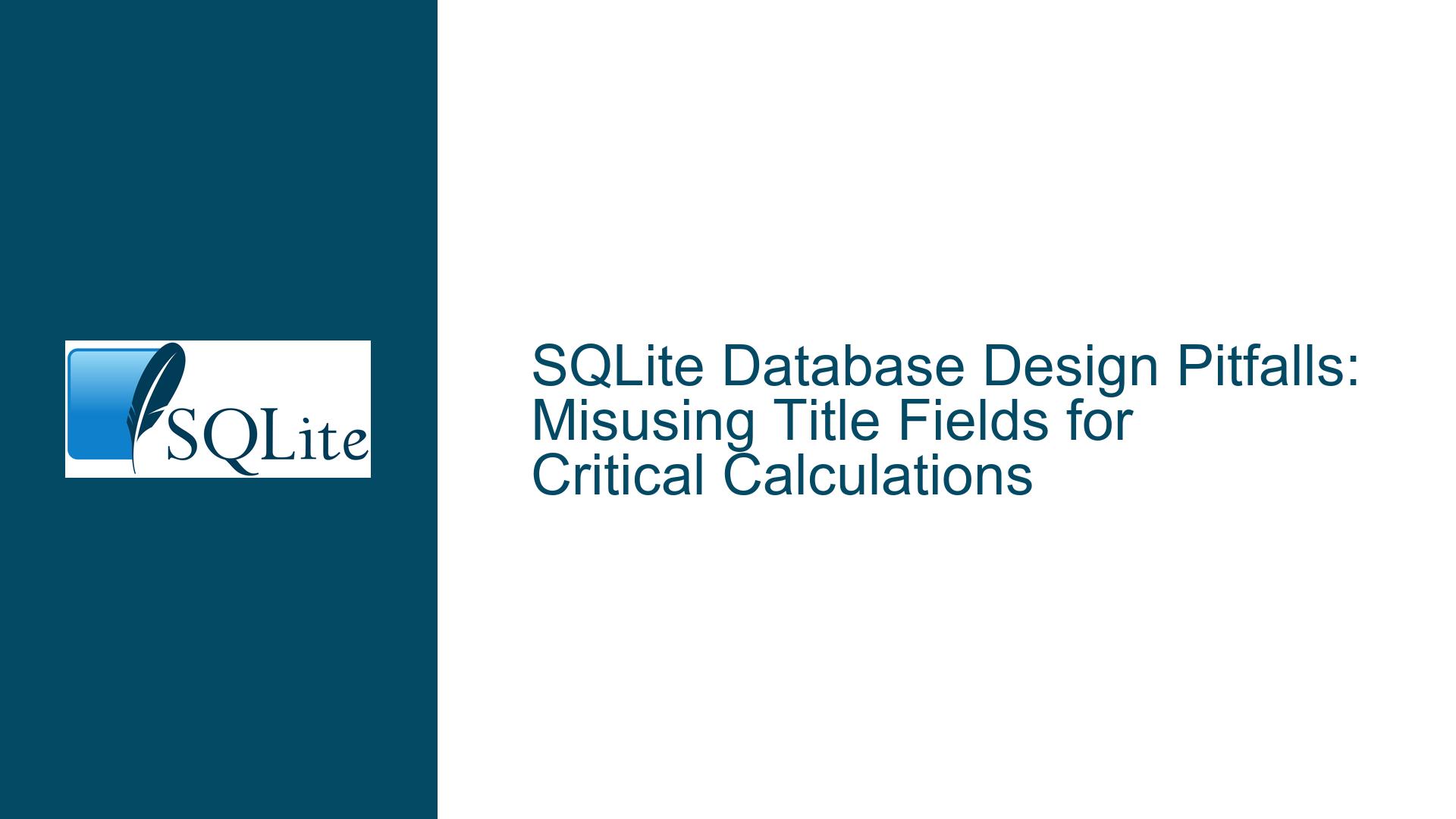SQLite Database Design Pitfalls: Misusing Title Fields for Critical Calculations
Misuse of Title Fields for Weight Calculations in Aviation Systems
The misuse of database fields, particularly title fields, for critical calculations such as weight and balance in aviation systems, can lead to severe operational failures. In the discussed scenario, a database field intended to store passenger titles (e.g., "Miss," "Ms") was incorrectly used to infer passenger weight categories. This led to a significant miscalculation in the aircraft’s total weight, resulting in insufficient thrust during takeoff. Such misuse highlights a fundamental flaw in database design and application logic separation. The title field, which should only be used for display or basic categorization, was repurposed for a critical calculation without proper validation or consideration of its limitations. This incident underscores the importance of understanding the purpose of each database field and ensuring that fields are not repurposed for unintended, critical calculations.
The core issue lies in the improper separation of concerns between the data tier and the business logic tier. The data tier should only store raw data, while the business logic tier should handle interpretations and calculations based on that data. In this case, the business logic incorrectly assumed that the title field could reliably indicate passenger weight categories, leading to a cascade of errors. This misuse is further exacerbated by the lack of validation and sanity checks in the database schema, allowing incorrect data to propagate through the system.
Interpreting Title Fields as Weight Indicators Without Validation
The primary cause of this issue is the misinterpretation of the title field as an indicator of passenger weight categories. This misinterpretation stems from a flawed assumption that titles such as "Miss" and "Ms" could reliably differentiate between children and adults. However, titles are not inherently tied to age or weight, and using them as such introduces significant risks. The database schema did not include any validation mechanisms to ensure that the title field was used appropriately, nor did it include any safeguards to prevent the misuse of this field for critical calculations.
Another contributing factor is the lack of a dedicated field for passenger weight. Instead of storing passenger weight directly, the system relied on inferred values based on the title field. This approach is inherently flawed, as it introduces unnecessary complexity and potential for error. A dedicated weight field would have allowed for direct and accurate weight calculations, eliminating the need for inference and reducing the risk of errors.
Additionally, the database schema did not include any comments or documentation to clarify the intended use of the title field. While SQLite allows for comments within the CREATE TABLE statement, these comments were either absent or insufficient in this case. Proper documentation could have provided clarity on the intended use of the title field, potentially preventing its misuse.
Implementing Dedicated Weight Fields and Proper Data Validation
To address this issue, several steps must be taken to ensure that database fields are used appropriately and that critical calculations are based on accurate and validated data. The first and most crucial step is to introduce a dedicated field for passenger weight. This field should be explicitly designed to store the weight of each passenger, with appropriate data types and constraints to ensure accuracy. For example, the field could be defined as a REAL type in SQLite, with a CHECK constraint to ensure that the weight is within a reasonable range (e.g., greater than 0 and less than 500).
CREATE TABLE passengers (
id INTEGER PRIMARY KEY,
name TEXT NOT NULL,
title TEXT,
weight REAL CHECK (weight > 0 AND weight < 500)
);
In addition to introducing a dedicated weight field, it is essential to implement proper data validation mechanisms. This includes validating the title field to ensure that it is used only for its intended purpose (e.g., display or basic categorization) and not for critical calculations. One approach is to use a CHECK constraint to limit the possible values of the title field to a predefined set of valid titles.
CREATE TABLE passengers (
id INTEGER PRIMARY KEY,
name TEXT NOT NULL,
title TEXT CHECK (title IN ('Mr', 'Ms', 'Mrs', 'Miss', 'Dr')),
weight REAL CHECK (weight > 0 AND weight < 500)
);
Furthermore, it is crucial to document the intended use of each field within the database schema. SQLite allows for comments within the CREATE TABLE statement, which can be used to provide clarity on the purpose and limitations of each field. This documentation should be comprehensive and accessible to all developers working on the system.
CREATE TABLE passengers (
id INTEGER PRIMARY KEY, -- Unique identifier for each passenger
name TEXT NOT NULL, -- Full name of the passenger
title TEXT, -- Title of the passenger (e.g., Mr, Ms, Mrs, Miss, Dr)
weight REAL -- Weight of the passenger in kilograms
);
Finally, it is essential to review and update the business logic to ensure that it correctly uses the dedicated weight field for critical calculations. This includes updating any queries, functions, or procedures that rely on the title field to instead use the weight field. Additionally, the business logic should include appropriate error handling and validation to ensure that the data used in calculations is accurate and within expected ranges.
By implementing these changes, the system can avoid the pitfalls of misusing database fields for critical calculations and ensure that data is used appropriately and accurately. This approach not only addresses the immediate issue but also provides a foundation for more robust and reliable database design in the future.
Conclusion
The misuse of title fields for critical calculations in aviation systems highlights the importance of proper database design and the separation of concerns between the data tier and the business logic tier. By introducing dedicated fields for critical data, implementing proper validation mechanisms, and documenting the intended use of each field, developers can avoid similar issues and ensure that their systems are robust, reliable, and safe. This incident serves as a valuable lesson in the importance of understanding the purpose of each database field and the potential consequences of misusing them.






